If you want that truly unique floor you can consider the combining of flooring materials. The most common flooring materials to be combined are hardwoods and natural stones such as marble and granite, as shown in Figure 1, although the combining of hardwoods with ceramic and porcelain tiles is not uncommon.
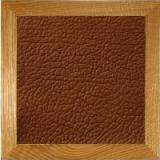
Figure 2 - Red oak with asian buffalo leather floor tile
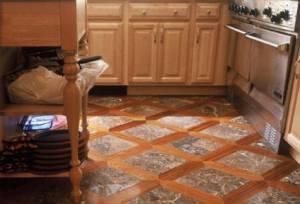
Figure 1 - Hardwood and marble floor
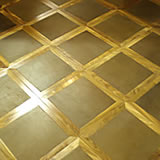
Figure 3 - Hardwood and leather floor
It should be pointed out up front that this is not a project for a novice or even intermediate level home handyman. Expert level experiece is necessary in order to create a finished project that has aesthetic value.
New flooring material combinations include floor tiles that are made of a frame of hardwood with a leather insert, as shown in Figures 2 and 3. It should be noted that these hardwood/leather flooring tiles are easier to install then a standard hardwood/tile floor as the hardwood/leather flooring tiles are pre-fabricated as one unit.
There are numerous challenges involved in combining flooring materials. As an example the installation of natural stone, ceramic or porcelain tiles involves the use of water. Water is an enemy of hardwood flooring.
As well, hardwood flooring, either boards, slats or engineered hardwood will be a different thickness than the natural stone, ceramic or porcelain tiles. Having all the flooring materials end up at the same height is critical to a properly installed combination floor.
Another consideration is the expansion and contraction characteristics of the materials. While natural stone, ceramics and porcelain expand and contract very little, hardwood can change dimensions dramatically if the relative humidity (RH) in the home changes. Hence, if you are going to install a combination floor it is important that you have an HVAC system that can maintain the relative humidity at a constant level throughout all seasons.
I therefore suggest that if you are considering a combination floor, that you contract with a flooring company that has the experience and capabilities to work with all of the flooring materials being used, rather than one company to do the hardwood and another to do the natural stone or ceramics.

Figure 4 - Stone border for a hardwood floor
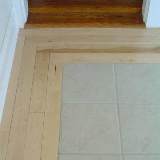
Figure 5 - Hardwood border for ceramic tile floor

Figure 6 - Hardwood floor inset in a ceramic tile floor
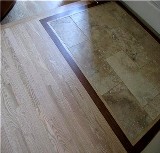
Figure 7 - Natural stone inset in a hardwood floor
If you would like to combine materials and want to do it yourself, you can lay a standard hardwood floor and use a stone medallion or stone borders, as shown in Figure 4, to compliment the floor.
Additional information on installing medallions in hardwood floors.
Additional information on installing borders in hardwood floors.
Or, you can use hardwood as a border around a natural stone or ceramic floor, as shown in Figure 5 or visa versa.
If you feel more creative you can insert a hardwood floor into a ceramic tile floor, as shown in Figure 6.
Figure 7 shows the installation of hardwood in a foyer, with an insert of natural stone directly in front of the door. This provides excellent protection for the hardwood flooring against any debris or water that come into the home as individuals enter from the outside.
A common occurrence of insetting a different flooring material occurs around fireplace hearths. Most individuals do not want wood to close to a fireplace in case a small lit ember should end up on the floor. Transitioning from a natural stone flooring, in front of the hearth, to a hardwood flooring for the rest of the room.
Although there are no hard and fast rules, primarily because this is a relatively new process, it is generally recommended that materials that require water for their installation be installed first and that materials such as hardwood, which do not react well with water, be installed last. You may find installers that disagree with this and you should allow your competent
installer to do what the project in a manner that they will guarantee.
The design you choose for your combined floor is constrained only by your imagination. However, the more complex the design, the more different materials that are used and the more areas where different materials butt up against one another, the more labor intensive the project will be, and hence, the more expensive that it will be.
Additional information on flooring
